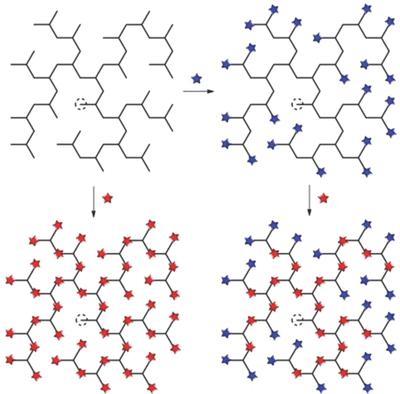当前位置:
X-MOL 学术
›
Macromol. Rapid Commun.
›
论文详情
Our official English website, www.x-mol.net, welcomes your feedback! (Note: you will need to create a separate account there.)
Hyperbranched Aliphatic Polyester via Cross‐Metathesis Polymerization: Synthesis and Postpolymerization Modification
Macromolecular Rapid Communications ( IF 4.6 ) Pub Date : 2017-12-18 , DOI: 10.1002/marc.201700658 Fu-Rong Zeng 1 , Ji-Mei Ma 1 , Lin-Hao Sun 1 , Zhen Zeng 1 , Hong Jiang 1 , Zi-Long Li 1
Macromolecular Rapid Communications ( IF 4.6 ) Pub Date : 2017-12-18 , DOI: 10.1002/marc.201700658 Fu-Rong Zeng 1 , Ji-Mei Ma 1 , Lin-Hao Sun 1 , Zhen Zeng 1 , Hong Jiang 1 , Zi-Long Li 1
Affiliation

|
A novel postpolymerization modification methodology is demonstrated to achieve selective functionalization of hyperbranched polymer (HBP). Terminal and internal acrylates of HBP derived from cross‐metathesis polymerization (CMP) are functionalized in a chemoselective fashion using the thiol‐Michael chemistries. Model reactions between different thiols (benzyl mercaptan and methyl thioglycolate) and acrylates (n‐hexyl acrylate and ethyl trans‐2‐decenoate) by using dimethylphenylphosphine or amylamine as the catalyst are investigated to optimize the modification protocol for HBP. High‐molecular‐weight HBP P0 is generated through CMP of AB2 monomer 2, a compound containing one α‐olefin and two acrylate metathetically polymerizable groups. CMP kinetics is monitored by NMR and gel permeation chromatography (GPC). Accordingly, microstructural analysis is conducted in detail, and CMP procedure is optimized. Postpolymerization modification of HBP P0 is performed via two distinguished strategies, namely one‐step complete modification and sequential modification, to generate terminally and/or internally functionalized HBPs P1–P3 in a chemoselective fashion by using phosphine‐initiated and/or base‐catalyzed thiol‐Michael chemistries. Finally, thermal stability and glass transition behaviors of HBPs P0–P3 are studied by thermal gravimetric analysis (TGA) and differential scanning calorimetry (DSC), respectively.
中文翻译:

通过交叉复分解聚合的超支化脂肪族聚酯:合成和后聚合改性
一种新型的后聚合改性方法论被证明可以实现超支化聚合物(HBP)的选择性功能化。交叉复分解聚合(CMP)衍生的HBP的末端和内部丙烯酸酯通过硫醇-迈克尔化学方法以化学选择性方式官能化。以二甲基苯基膦或戊胺为催化剂,研究了不同硫醇(苄硫醇和巯基乙酸甲酯)与丙烯酸酯(丙烯酸正己酯和反式-2-癸烯酸乙酯)之间的模型反应,以优化HBP的修饰方案。高分子量HBP P0通过AB 2单体2的CMP生成,是一种包含一个α-烯烃和两个丙烯酸酯可热聚合基团的化合物。CMP动力学通过NMR和凝胶渗透色谱(GPC)进行监控。因此,详细进行了微观结构分析,并优化了CMP工艺。HBP P0的聚合后修饰是通过两种独特的策略进行的,即一步完成修饰和顺序修饰,通过使用膦引发的和/或碱催化的硫醇以化学选择性的方式生成末端和/或内部官能化的HBP P1 - P3。迈克尔化学。最后,HBP P0 – P3的热稳定性和玻璃化转变行为 分别通过热重分析(TGA)和差示扫描量热法(DSC)研究。
更新日期:2017-12-18
中文翻译:

通过交叉复分解聚合的超支化脂肪族聚酯:合成和后聚合改性
一种新型的后聚合改性方法论被证明可以实现超支化聚合物(HBP)的选择性功能化。交叉复分解聚合(CMP)衍生的HBP的末端和内部丙烯酸酯通过硫醇-迈克尔化学方法以化学选择性方式官能化。以二甲基苯基膦或戊胺为催化剂,研究了不同硫醇(苄硫醇和巯基乙酸甲酯)与丙烯酸酯(丙烯酸正己酯和反式-2-癸烯酸乙酯)之间的模型反应,以优化HBP的修饰方案。高分子量HBP P0通过AB 2单体2的CMP生成,是一种包含一个α-烯烃和两个丙烯酸酯可热聚合基团的化合物。CMP动力学通过NMR和凝胶渗透色谱(GPC)进行监控。因此,详细进行了微观结构分析,并优化了CMP工艺。HBP P0的聚合后修饰是通过两种独特的策略进行的,即一步完成修饰和顺序修饰,通过使用膦引发的和/或碱催化的硫醇以化学选择性的方式生成末端和/或内部官能化的HBP P1 - P3。迈克尔化学。最后,HBP P0 – P3的热稳定性和玻璃化转变行为 分别通过热重分析(TGA)和差示扫描量热法(DSC)研究。


























 京公网安备 11010802027423号
京公网安备 11010802027423号